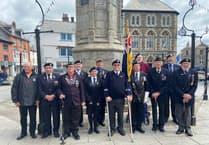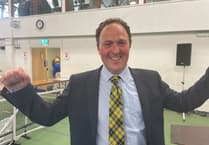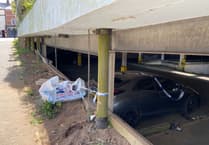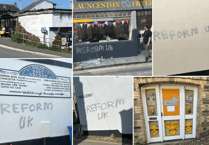LAUNCESTON is packed with history, but the past of its focal newspaper, The Cornish & Devon Post, could be somewhat of a mystery to many.
This mystery will be uncovered by the Oracle of Launceston, Jim Edwards, as he unveils how the Post really began in the mid Victorian period, with hopes for a new factual book on the community newspaper to be the result of his extensive research.
Jim, who has been fittingly nick-named ‘the Oracle’ by fellow local historian Roger Pyke, arguably knows everything there is to know about the ancient town of ‘Lanson’, from its buildings to the people and all the local myths and quirky tales.
However, now he’s delving into a new project — uncovering the world of local printing, writers and the old machinery used to make the area’s best known community newspaper, The Cornish & Devon Post.
Jim, who spends a lot of his spare time in Launceston Library researching local history, spoke to the Post about what we can expect from his upcoming project.
He said: “People look at it as just local news. It’s more than that — it’s the light of the world.”
He mentioned Arthur F Robins, who used to sneak into political meetings of Launceston Town Council and report back to the public on what was said. Arthur’s brother was chief press officer of one of the Birmingham papers, and soon after Arthur also went on to become chief press officer of the London papers.
Jim explained that there were four original men who bought into making the Post what it is today. He has knowledge of printing in Launceston from the mid 1800s, and has collected the names and works of many past editors.
One such editor was Charles Orchard Sharpe, a journalist, who arrived in the town in 1904 and became the editor of the Cornish & Devon Post.
As reported in the Post in 2018 by one of our current reporters, Charles was very supportive of the idea that women could do farm work just as well as men, if given the chance, as Britain was in great danger of starvation in 1915 and 1916 due to Germany’s blockage on supplies by sea.
Therefore, Charles helped set up a demonstration by ladies at Scarne Farm in March 1916 and supplied the advertising in the paper.
Jim said: “Most of the editors of ‘The Weekly’ worked with the people, helping where they could for the good of the communities in their many outlets.
“Many people were thankful for news of their friends and relatives by way of the paper, especially when actual letters were printed of family news, good, bad or just friendly.
“Many rural families were glad of information, explanations of new laws, where to get help for most troubles, and even information of relatives and friends who lived or worked abroad. Collecting such was the work of a good editor and most were very good at their chosen trade.
“Editors relied on local people in the villages who supplied them with intimate information of local goings on, such as births, deaths, marriages and village celebrations, who sent their information by hand, later by telegram, telephone and by just dropping in at the office when shopping. Putting all this together in a readable fashion, with due dignity, was the editor’s speciality.”
Jim also has dates when the office of the Post was upgraded to Westgate Street from a small room in the town square. He added: “I have a long list of persons connected — by making news, supplying news, of local public orders and laws, of the drunks, of the many churches and chapels, of medical matters, and good works.”
He said: “It’s all connected. It is the history of Lanson. Four people got together and provided the money. When the little shop they had got too small, they moved to Westgate Street into the upstairs room. Then eventually they bought this place, which was the old cycle shop.”
As things began to modernise, Jim has one vivid memory. He said: “I remember standing outside the building as they took all the press prints out of the window! They used big cranes to remove them.
“To me, it’s more than a newspaper. It’s an essential part of the town! What I want to do is get all the little things together and put them in an order so it tells the stories of the town.
“You have people like Arthur Venning, who was a hero in World War Two. He was told to go up to the front, and of course all the road signs had disappeared because of the shelling. He ended up getting behind enemy lines! Eventually he joined up with the British again and paid them off.
“Arthur Robins was a representative for the London papers. Then there was his brother and their sons — they all bought into the paper. The church in Fleet Street, London, was bombed during World War Two. The official photographer for the London fire brigade was there taking photographs and it shows the church on fire. But you could just make out something hanging onto the walls — it was the Robins memorials, there was three of them. They were all repaired when the church was rebuilt.”
Also noted in Jim’s research is a trainee reporter who sadly went down with a convoy ship during one of the world wars, as well as a vicar from South Petherwin who was taken ill in Egypt and, when asking for a blanket on the deck of the ship he was travelling on, was handed a blanket designed by a group of Launceston women — which he then set about presenting to them on his return to the area.
Jim’s hopes for his mountains of research on the Post and its stories from the past is to produce a book.
He said: “It would be nice to create a book for someone to keep or put around the libraries. There are records of more and more editors — I can name five or six. One of the earliest I remember here is from Camelford, then more recently another from Holsworthy.”
As he works towards producing a book on the Post’s history, Jim will be providing us with all the past stories of editors, reporters and local journalism, and printing in the area — all of which formed what the Post is today.
Jim added: “I never write ‘the history of’; it’s ‘a history of’ — it’s the way I see it. History never finishes.”





Comments
This article has no comments yet. Be the first to leave a comment.